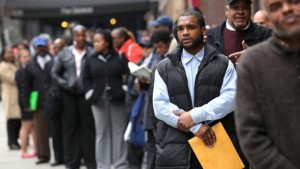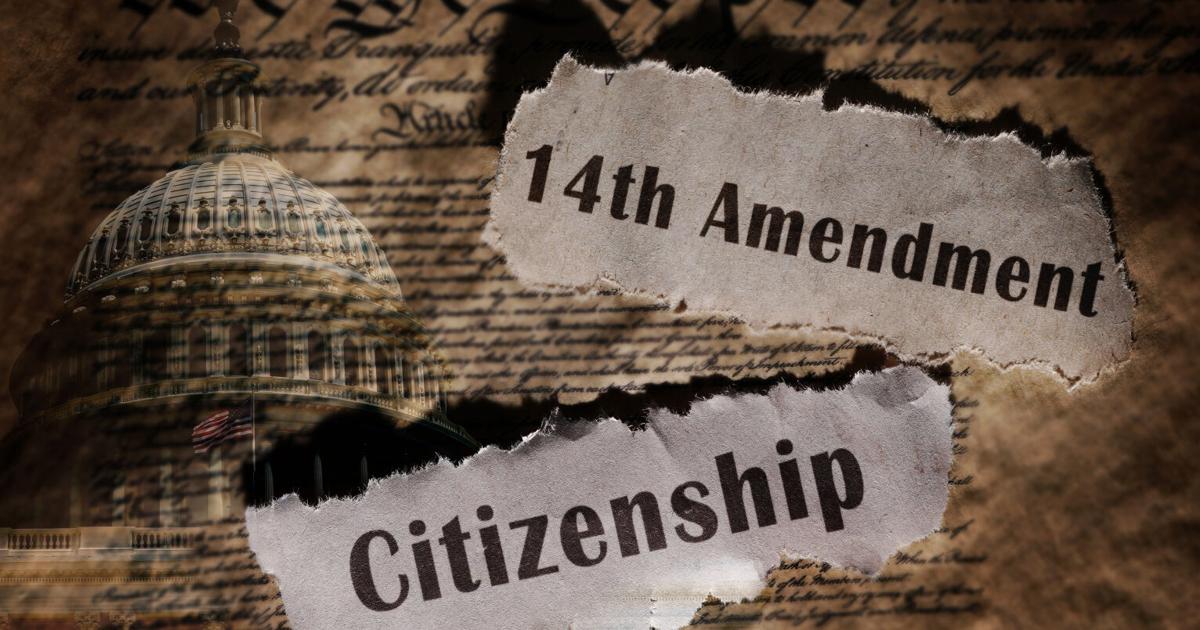(ThyBlackMan.com) We are in a new economy where up is down and down is up. Damn if you do and damn if you don’t. The national unemployment rate for blacks in February clocked in at 10.4 percent. That rate is an increase from January, which was 10.3 percent and matches December’s unemployment rate for African Americans. In the last three months, African Americans as a group have seen their unemployment rate increase, even as the national rate decreased. Consider this or rather give the following some thought; 2009 was the year the economy emerged from the deepest recession since the 1930s, due to the fallout resulting from the housing crisis. The recession or contraction of the economy began in December 2007 and ended in June 2009, according to the National Bureau of Economic Research. They determined this in September of 2010, as they looked back and charted the beginning and ending of the economic downturn.
The national unemployment rate peaked at 10.0 percent in October of 2009. However, the black unemployment rate did not peak until August of 2011 at 16.7 percent. The current rate of black unemployment, as indicated above, is higher than the 10.0 percent peak of the unemployment rate reached nationally in 2009. When you consider the black unemployment rate has not been under 10.0 percent for the last seven years, you can profoundly appreciate the overall dismal economic state of the black community. At the end of day, whether a given worker group is gainfully employed matters. This cannot be sloughed off with statements like “there are plenty of jobs, they just don’t want to work” or “they just want to start at the top with the easy jobs.” These numbers are revealing and demonstrate the need for a national job creation plan now, as the Obama administration, and indeed this country must face the fact that this economy is not producing enough good jobs
demonstrate the need for a national job creation plan now, as the Obama administration, and indeed this country must face the fact that this economy is not producing enough good jobs
(http://www.thefixthistime.com)! African Americans are dealing with some very tough and difficult economic realities.
The Federal Reserve Bank (Fed), our central banker, fought high “unemployment rates” caused by the Great Recession through aggressively cutting interest rates beginning in 2008. Through cutting interest rates, the Fed created an atmosphere which led to job creation based on easy money. Having maintained interest rates at historic lows, near zero, the Fed is now preparing to raise interest rates. Not everyone benefited equally as the Fed lowered interest rates based on the above black unemployment numbers. The national unemployment rate for February is 5.5 percent and the white unemployment rate for the same period is 4.7 percent. Whites have benefited handsomely from reduced interest rates. Thus, the larger population, Hispanics and Asians as measured worker groups, have all benefited and have single digit unemployment rates. Nevertheless, the Bureau of Labor Statistics (BLS) states there are still officially 8.7 million Americans unemployed, and 2.7 million or 31.1 percent of those are long term unemployed (those jobless for 27 weeks or more).
With these conditions as the backdrop the Fed is considering raising interest rates, perhaps as soon as June of this year. Why is the Fed doing this you may ask? Many of us know as the cost of money increases, there is a good possibility hiring will slow or even stop, as higher interest rates cut into the profits of businesses. Especially, with so many workers unemployed, and the African American unemployment rate at 10.4 percent, why would the Fed risk an economic slow down that could cause unemployment to get worst? Don’t they know there are millions of people out of work, well beyond the stated government official number of 8.7 million workers (experience teaches us the government is not always accurate)? Furthermore, those of us who closely follow these numbers agree that the true unemployment rate is higher by as much as two to five percent or more.
The short answer to the question of why the Fed is considering raising interest rates at this time maybe that the Fed is out of bullets to use in the event of another financial crisis. If interest rates are already at or near zero and a financial crisis strikes the American financial system as devastating as the housing crisis, what tools would the Fed have available to use? It can’t very well lower interest rates which are already at zero to stimulate or revive the economy. Additionally, a new round of quantitative easing (QE) would not go down well with the investment community and Republicans in Congress who are the new majority as the Fed balance sheet currently is over four trillion dollars. You see, the Fed simply printed the money it used as part of its QE program, which aided in keeping interest rates near zero. Some economists and many in Congress just were uncomfortable with that maneuver.
An example of what the Fed did would be similar to you using the Fed’s one hundred dollar bill plates along with its printing presses and for the last six years, you printed money in your basement to pay your bills. That is what the Fed did in essence. It paid the federal government bills from 2008 to 2014 through printing money! It then used that money to purchase government debt in the form of bonds, and those bonds are still on its balance sheet. Please note, the money used for these purchases did not come from collected taxes and tariffs! Therefore, in an attempt to exercise leverage over the economy, in the event a new economic bubble bursts or some yet unforeseen financial debacle occurs, the Fed has chosen to increase interest rates. The question arises as the Fed tightens, will the black unemployment rate increase?
African Americans are in the unfortunate and unenviable position of being the worker group that is the first laid-off as the economy turns downward. Whites, nor Asians or Hispanics have this distinction among worker groups followed by the BLS. Therefore, blacks are in a way the canaries in the mine in the Fed’s grand experiment. The Wiktionary (a dictionary of sorts) defines the canary in the mine concept the best. Its states it an allusion to caged canaries (birds) that miners would carry down into the mine tunnels with them.
If dangerous gases such as methane or carbon monoxide leaked into the mine, the gases would kill the canary before killing the miners, thus providing a warning to exit the tunnels immediately. Well, as the Fed raises interest rates, blacks will no doubt be affected first as a group because of their reputation of being the first laid-off, however, as with the miners, there is no exit for them. Will this experiment be successful or will this recovery fail? The Fed is suggesting they can incrementally increase interest rates or rather increase the price of money without increasing the unemployment rate. “What do you think?” When I look at this scheme, it reminds me of Marvin Gaye’s song. Gaye had it right when he asked, “What’s Going On?” Tell me what’s going on?”
Staff Writer; James Davis
This talented brother is a graduate of Florida A. and M. University(FAMU), a former stockbroker, and a human rights activist who resides in Sanford, Florida. He was awarded the prestigious Governor Haydon Burns Scholarship to attend FAMU and while at FAMU was awarded the first Martin Luther King Scholarship. He is also author of three books, among them are “The Fix This Time,” Expanding Social Security Benefits to Create Jobs and Spur Demand( http://www.amazon.com/dp/B00MI3PD2M ) and “Hey…God’s Talking To You,” The Study Book ( http://www.amazon.com/dp/B00GYI3VQW ).
He can be reached through his blog @, (http://www.thefixthistime.com).

















@James Davis-
You really aren’t saying anything. Your conclusions are illogical. Even if blacks had access to SS funds ,that does not mean they’d take the money and start businesses with it. So, again, you are making a alot of assumptions.
@ marcus v-
Whatever reason you want to justifiy it, blacks are INDEED being squeezed out of the job market. If they weren’t then there would be no reason why the unemployment rate for blacks with college degrees would be higher than every other ethnic group. This includes blacks with STEM degrees (where the greatest need is). So, you analyze that.
Regarding your black business fact. Even if what you said is true (which I doubt), this does not negate what I said about blacks not building a viable economic base. Just registering an LLC with your state is considered starting a business. I’m not talking about simply ‘starting a business’ but building a base where you are able to employ the people. Where are those businesses you mentioned today? We are not building the kind of sustainable businesses that can impact the unemployment rate and build a community.
Sorry, but there were no inaccuracies in my post.
James Davis –
“Well, as the Fed raises interest rates, blacks will no doubt be affected first as a group because of their reputation of being the first laid-off, however, as with the miners, there is no exit for them. Will this experiment be successful or will this recovery fail? The Fed is suggesting they can incrementally increase interest rates or rather increase the price of money without increasing the unemployment rate. “What do you think?””
I think raising rates is long overdue. If done right I don’t think it will impact the recovering economy at all. The recovery is now sustaining itself and to keep rates low would create longer run negative consequences than benefits.
You are correct however in your assertion that any negative cost will fall on Blacks first and any positive gains will fall on Blacks last.
Reality_check –
The structure of the workforce has changed, Black folk are not being squeezed out of the labor force. Everywhere I go I hear the need for skilled labor, the increased need for pre-vocational and vocational trade labor there is a HUGE demand for the type of workforce we can produce as Blacks. We just have to reorient our educational systems.
Secondly, Blacks created more businesses between 1997 and 2007 than any other group.
Just want to point out a few inaccuracies you put out there.
@ Reality_check:
It is good to see that you are beginning to connect the dots, in that you have come to realize nothing happens without money in the realm of business creation. In other words you just don’t up and start recurrently or regularly creating African American businesses without an unfettered and continuous source or stream of risk capital or money flowing into the hands of African Americans.
You are correct in your conclusions, however, regarding African American capital or money, in that it is spent on consumption (we have already acknowledged that)and given to the black church. But you have to stretch your mind and expand your thinking ( that is what I meant by thinking in the shallows). Think deeply! What other place do African Americans spend money consistently. I’ll tell you where! They recurrently or repeatedly contribute money to the federal government like all working Americans who earn up to $118,500.00 annually in the form of Social Security payroll taxes. Their contributions are matched by their employers. This is their money and it can be accessed by them at age 62 ( early retirement) or age 66 or over( full retirement). Now, what if African Americans and all workers for that matter demanded access to this money in a way that is not now being allowed by the Social Security Administration. After all you have the constitutional right to petition your government for change when it is in your best interest. What if African Americans and other working Americans were allowed to take down 10-12% of their retirement principal at the time they retire, leaving 88% to 90% of the principal left to be received monthly as an annuity. Stretch your mind now! You are no doubt wondering how much would that be annually dropping just into African American hands. Remember, this money would be unfettered by white racists and come directly to African Americans. Well I have done the math for you. It would be somewhere in the area of $14.9 billion dollars annually and that‘s just to African Americans. I am not suggesting by a long shot all this money would go into creating businesses, but some of it will.
“The Fix This Time,” goes into detail about the storied history of the Social Security trust fund. It shows you the method and means of how this can be done. That’s why I say you got to read the book to know how to execute the plan. No one who has actually read the book comes away saying this is not doable. They are usually enthused to know there is really a legitimate answer to our dilemma. I am due to meet with a group of black ministers in the coming weeks. I will go over this plan with them, however I have required they purchase the book. We will walk through the plan with the book in front of them. I’ll know I have succeed when I see the look on their faces, as I have seen the look on so many other faces I have reviewed the plan with, that says, “I get it.” You know what their usual response is and it is becoming constant. It is, “Wow, this changes everything!” I am available to meet with your group also.
Economic freedom is within our reach! To me, it appears we would rather stand outside, talk about and throw rocks at a system that has been created to make it difficult for African Americans to achieve economic freedom, rather than anatomically taking that system apart and seeing how it works and how it can be used to our advantage. That’s where I come from, I like to intellectually tinker. I hope I was helpful. God’s speed to you and yours.
http://www.thefixthistime.com
To reality_check:
It is good to see that you are beginning to connect the dots, in that you have come to realize nothing happens without money in the realm of business creation. In other words you just don’t up and start recurrently or regularly creating African American businesses without an unfettered and continuous source or stream of risk capital or money flowing into the hands of African Americans.
You are correct in your conclusions, however, regarding African American capital or money, in that it is spent on consumption (we have already acknowledged that)and given to the black church. But you have to stretch your mind and expand your thinking ( that is what I meant by thinking in the shallows). Think deeply! What other place do African Americans spend money consistently. I’ll tell you where! They recurrently or repeatedly contribute money to the federal government like all working Americans who earn up to $118,500.00 annually in the form of Social Security payroll taxes. Their contributions are matched by their employers. This is their money and it can be accessed by them at age 62 ( early retirement) or age 66 or over( full retirement). Now, what if African Americans and all workers for that matter demanded access to this money in a way that is not now being allowed by the Social Security Administration. After all you have the constitutional right to petition your government for change when it is in your best interest. What if African Americans and other working Americans were allowed to take down 10-12% of their retirement principal at the time they retire, leaving 88% to 90% of the principal left to be received monthly as an annuity. Stretch your mind now! You are no doubt wondering how much would that be annually dropping just into African American hands. Remember, this money would be unfettered by white racists and come directly to African Americans. Well I have done the math for you. It would be somewhere in the area of $14.9 billion dollars annually and that‘s just to African Americans. I am not suggesting by a long shot all this money would go into creating businesses, but some of it will.
“The Fix This Time,” goes into detail about the storied history of the Social Security trust fund. It shows you the method and means of how this can be done. That’s why I say you got to read the book to know how to execute the plan. No one who has actually read the book comes away saying this is not doable. They are usually enthused to know there is really a legitimate answer to our dilemma. I am due to meet with a group of black ministers in the coming weeks. I will go over this plan with them, however I have required they purchase the book. We will walk through the plan with the book in front of them. I’ll know I have succeed when I see the look on their faces, as I have seen the look on so many other faces I have reviewed the plan with, that says, “I get it.” You know what their usual response is and it is becoming constant. It is, “Wow, this changes everything!” I am available to meet to your group also.
Economic freedom is within our reach! To me, it appears we would rather stand outside, talk about and throw rocks at a system that has been created to make it difficult for African Americans to achieve economic freedom, rather than anatomically taking that system apart and seeing how it works and how it can be used to our advantage. That’s where I come from, I like to intellectually tinker. I hope I was helpful. God’s speed to you and yours.
http://www.thefixthistime.com
@James Davis, here you go with this risk capital again, I think we’ve run into each other before on these message boards. I disagree with you: BLACKS HAVE THE CAPITAL YOU SPEAK OF….it’s just that most of our capital goes out the door because of consumerism, or is tied up in the church where we get ZERO return.
Look bro, blacks as a collective have the money. We just choose not to use it to build an economic base for ourselves.
That, my friend, is the answer to the questions you ask.
To reality_check:
As racism becomes more subtle and opaque, it is important that African Americans gain more control over the economies of their neighborhood. That’s a given. I could not agreed with you more that black people need a plan to evolve from being a 99% consumer to a producer or manufacturer. So what are the logical questions one must ask him or herself in the process of formulating such a plan to accomplish that goal.
#1) To accomplish such a goal, African Americans are going to need money or risk capital. The majority population and any other population for that matter are not geniuses when it comes to creating businesses. However, what they have is something that is denied to blacks and that is money or seed money or risk capital which they can call upon and use in pursuit of their business ambitions.
Thus, blacks have to ask the question, from where is the risk capital in large enough amounts to start business going to come?
#2) Once that question has been answered and African Americans access that risk capital and start some successful businesses – the next question that has to be tackled and consummately answered is from where will secondary funding come to expand those successful businesses? It’s a dummy or an idiot who believes once blacks start successful businesses in great numbers that there will not be some push back from racists.It has happened in the recent past and it should be anticipated.
Our world and I mean it when I say it is our world too, is beautiful and challenging with beautiful and loving people in it! We have a right to be here and occupy the space we are in just like every other race. However the world’s greatest and most tasteful fruits when it comes to business ownership which support jobs remain out of the reach of African Americans as a whole not because we are not trying hard enough, but because of shallow thinking. Realistically answer the questions above and we take our first steps toward success in this endeavor. However, before any of the above, let us realistically see if we can dig ourselves out of our current dilemma by coalescing behind the job creation plan described in the book I’ve written. I say to everyone who will listen, buy the book and start putting our economic house in order. You got to know what the plan is before you can execute it.
It is not beyond our reach if it is not beyond our ability to conceive it. We simply have to make that which we conceive happen.
http://www.thefixthistime.com
Now James Davis, you can offer such spot-on economic analysis, but you still don’t know what’s going on? Simply put: blacks are being squeezed out of the work force in the new millennium. We have outlived our usefulness and are not desired employees. This is why you see such high unemployment rates among blacks.
This is the result when we refuse to build and support our own. While everyone else is building their own economic base, we are still depending on others to do for that for us.
Sorry, but this is just how life works.